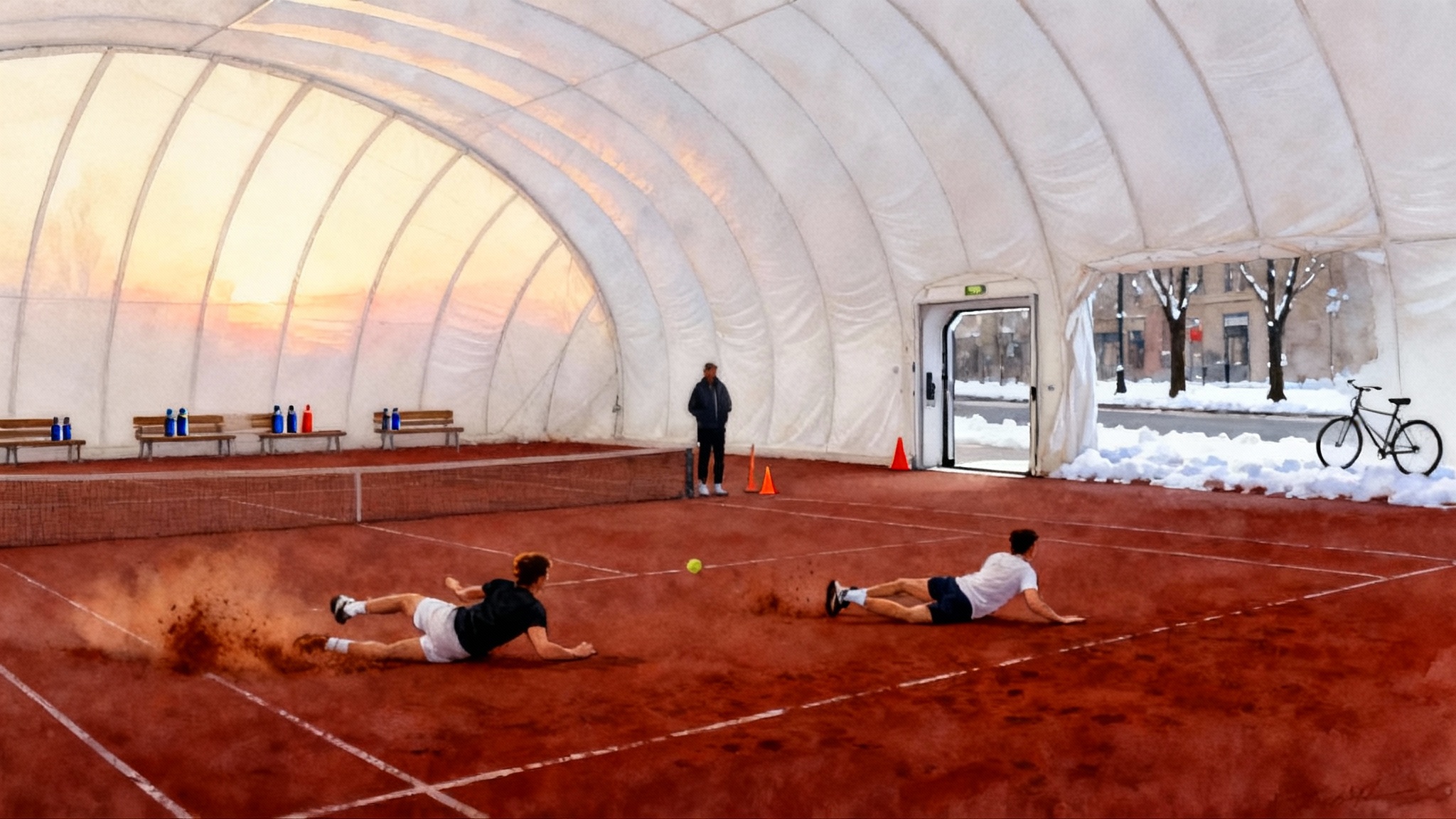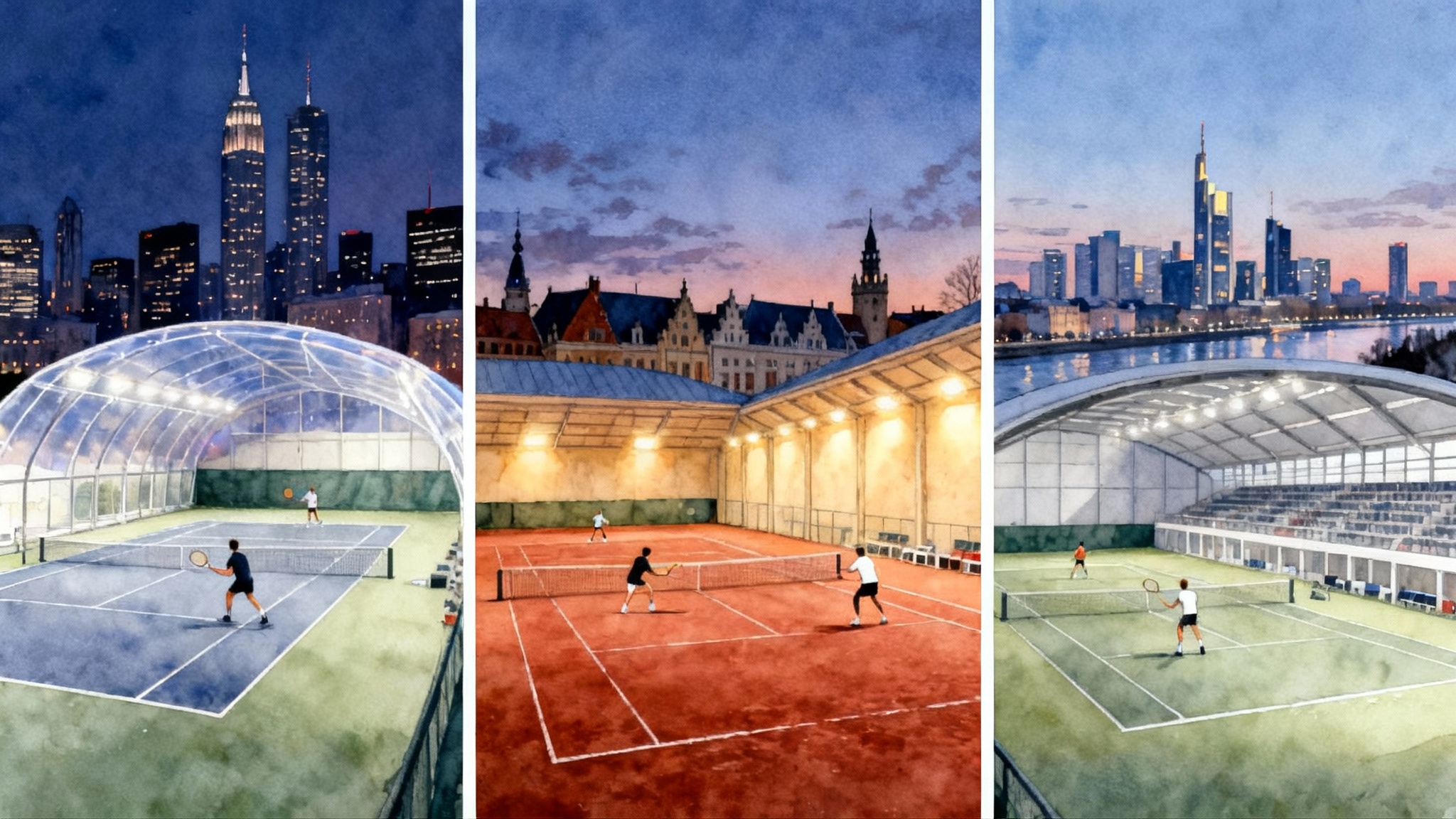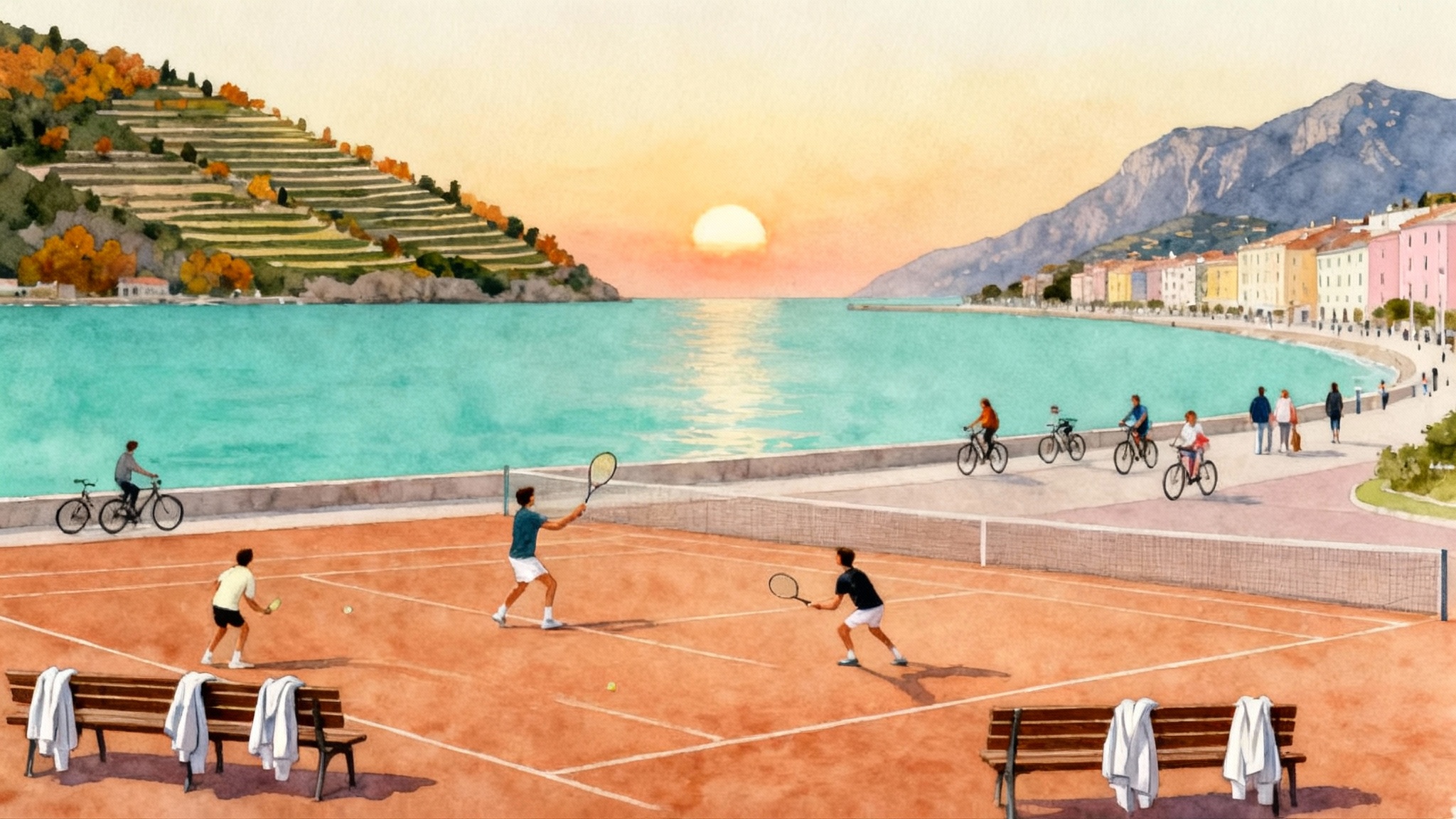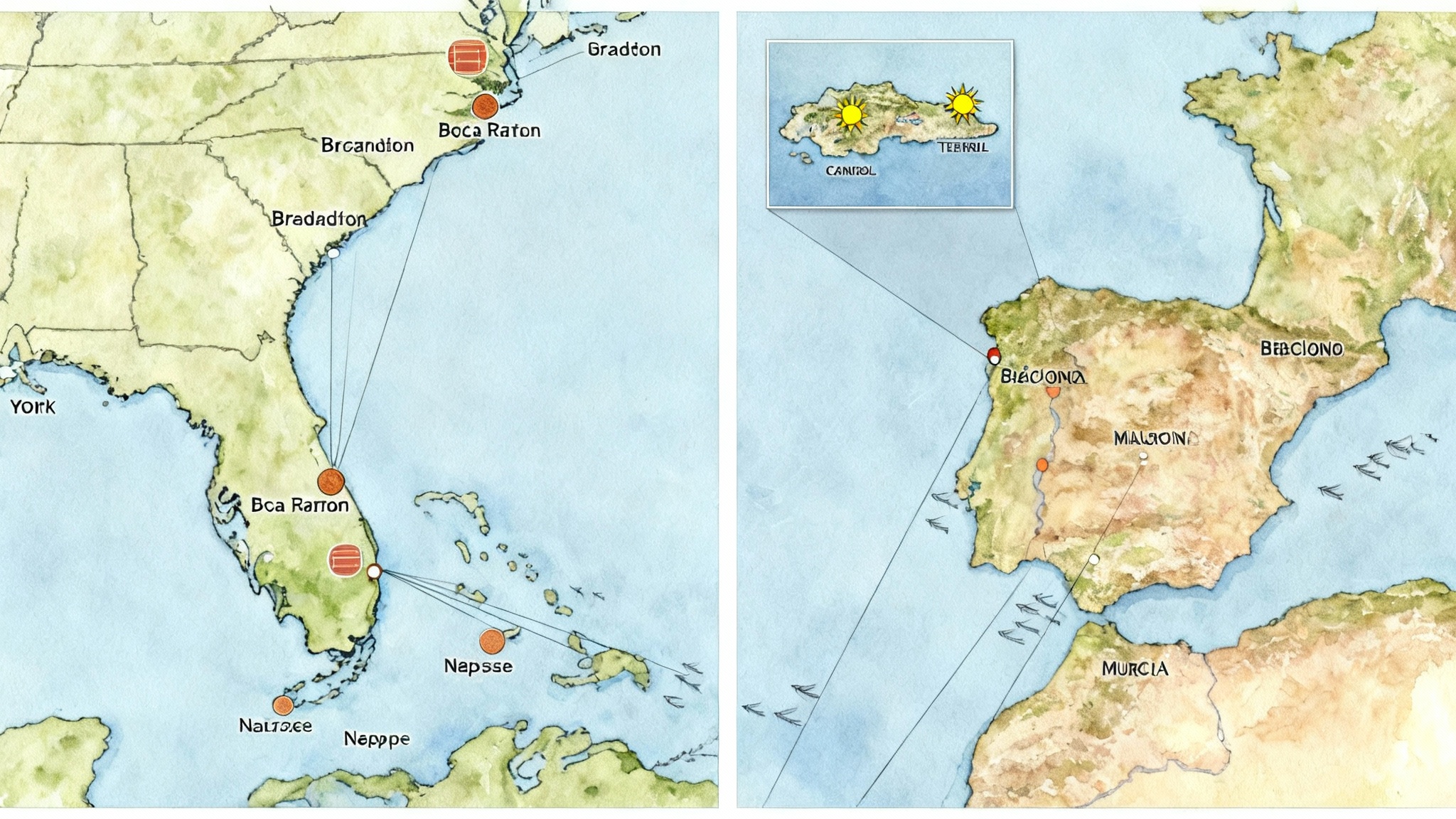North America Indoor Red Clay: November–March at ACE Toronto
Skip the Europe shuffle. Base your winter on Toronto’s year‑round red clay and keep improving from November to March. Here is why indoor clay accelerates development, how to plan flights, budgets, weekly structure, and tournaments.

Why indoor red clay in winter changes development
If you want better footwork, smarter patterns, and more resilient joints by spring, your surface choice from November to March matters. Indoor red clay gives you long, continuous rallies and sliding entries that demand small adjustments with every step. That repetition builds ankle stability, hip mobility, and timing you cannot fake on a fast indoor hard court. Movement patterns you engrain on clay carry over to every surface, but the reverse is not true.
Toronto has a rare asset in North America: year round red clay under a climate controlled bubble at Toronto Tennis City, home base of ACE Tennis. For program details and how the club structures training blocks, see the ACE Toronto academy overview. The club provides players with year round red Italian clay courts, which means you can train today and face a blizzard tomorrow without losing court time. That reliability is the heart of this plan.
Why choose ACE Toronto over a winter in Europe
Europe is the spiritual home of clay, but for North American players the travel tax is steep. Five to six time zones, overnight flights, and language logistics can steal a week every month from true training. ACE Toronto gives you the surface without the jet lag. You get the same movement training, similar rally length, and the same slow court feedback, while staying in Eastern Time and within a short hop of most U.S. hubs. For a global view of winter bases, compare options in our Winter 2025 training map.
A winter base in Toronto also lets you layer competition in Ontario and nearby U.S. states without changing continents. That consistency means more touches on the ball, more structured progression, and a lower chance of derailing your season with a midwinter overuse spike.
What indoor clay delivers that hard courts cannot
- Repeatable sliding entries and exits: You learn to arrive balanced, brake with the outside foot, and recover to neutral. On hard courts you often plant and push. On clay you glide and load. The system teaches you to feel the ball through your legs first, then the racquet.
- Longer points, smarter patterns: Players earn control by building space, not by rushing. You learn to create height and depth on the heavy ball to open the court. That patience shows up in March when early spring winds make timing tricky on outdoor hard courts.
- Lower impact for higher volume: Clay’s softness spreads force. You can stack on footwork ladders, shadow movement, and live points without the same joint toll. Volume is a development currency. Clay helps you spend more of it.
- Clear feedback: Footprints tell the truth. Recovery steps, contact points, and approach lines are literally drawn for your coach to review. You make visible changes quicker.
Climate reliability: Toronto bubble vs U.S. cold snaps
Even warm U.S. tennis states can lose days to rare freezes or winter storms. The 2024 to 2025 winter included a historic January 2025 snowstorm in the South, with record lows and widespread closures. A climate controlled bubble neutralizes those shocks. Toronto will have winter, but covered red clay means predictable training hours. Reliability beats optimism when you are trying to string together twelve to sixteen solid weeks. If you still want a warm weather option as a complement, see our guide to a Houston winter tennis base.
Getting there fast: flight logistics from major U.S. hubs
Toronto Pearson International Airport sits in Mississauga. Billy Bishop Toronto City Airport sits on the island close to midtown, a short rideshare from Yonge and Davisville. From most eastern and central U.S. hubs, you can be on court the same afternoon you travel.
Typical nonstop flight durations to Toronto, door to door planning time in parentheses:
- New York City to Toronto: about 1 hour 30 minutes flight time, plan 4 to 5 hours door to door
- Boston to Toronto: about 2 hours, plan 4 to 5 hours door to door
- Washington D.C. to Toronto: about 1 hour 30 minutes, plan 4 to 5 hours door to door
- Chicago to Toronto: about 1 hour 30 minutes, plan 4 to 5 hours door to door
- Atlanta to Toronto: about 2 hours 10 minutes, plan 5 to 6 hours door to door
- Miami to Toronto: about 3 hours, plan 6 to 7 hours door to door
- Dallas to Toronto: about 3 hours 10 minutes, plan 6 to 7 hours door to door
- Denver to Toronto: about 3 hours 30 minutes, plan 6 to 7 hours door to door
- Los Angeles to Toronto: about 5 hours, plan 8 to 9 hours door to door
Practical entry notes for U.S. citizens: bring a valid passport and plan for a simple customs interview. Trusted traveler programs like NEXUS can speed things up on return trips. Pack tennis gear in carry on so a delayed bag does not steal a session.
November to March framework: how to structure the season
Think about winter as a four block progression. Your end goal is competition ready movement, not just fitness.
- November, Foundation: Establish clay specific footwork, aerobic base, and serve rhythm. Volume is medium to high, intensity is conservative. Add flexibility and ankle strength.
- December, Skill and Pattern: Raise intensity and sharpen patterns. Serve plus one, return plus one, and approach patterns get priority. Integrate match play with constraints.
- January, Competitive Reps: Enter local or regional tournaments. Keep training volume steady but protect recovery days. Polish clay specific defense to offense transitions.
- February to early March, Consolidate and Peak: Enter a second wave of events, then taper in March before your spring outdoor shift.
Sample week blocks on indoor red clay
Below are two practical week templates you can run from November through March. Adjust hours for age and recovery.
Junior pathway, ages 13 to 17, competing in Tennis Canada or Universal Tennis Rating events
- Monday
Morning: School
Afternoon on court, 120 minutes: movement warm up, depth and height rally work, forehand inside out pattern, serve plus one neutral ball tolerance
Gym, 45 minutes: posterior chain strength and ankle stability, finish with mobility
Recovery: 15 minutes light bike or walk - Tuesday
On court, 90 minutes: return plus one patterns, second serve aggression, high ball backhand stability
Match play, 60 minutes: sets with crosscourt only rule for first four shots
Video, 20 minutes: annotate two points that reached ten strokes - Wednesday
On court, 120 minutes: defensive movement, slide to open stance, neutralize then transition to offense
Conditioning, 30 minutes: aerobic intervals on court with movement shuttles - Thursday
On court, 90 minutes: approach patterns, inside in to net, volley depth control
Match play, 60 minutes: short set with approach within first three neutral balls - Friday
On court, 90 minutes: serve day, targets and spins, second serve height, body serve on deuce
Strength, 30 minutes: upper body push pull balance, shoulder care and core - Saturday
Tournament or match day simulation, 2 to 3 hours - Sunday
Active recovery: 30 to 45 minutes mobility, optional 45 minute hit of simple crosscourt patterns only
Key clay movement cues to rehearse daily:
- Enter the ball with a small drop step, brake outside, then cross behind to recover
- Use height to protect depth, especially on defense
- Commit to footwork patterns between points to lower heart rate and reset
Competitive adult pathway, U.S. NTRP 4.0 to 5.0, aiming for league and prize money events
- Monday
On court, 90 minutes: footwork and balance ladders, low intensity crosscourt volume to build feel
Mobility, 20 minutes - Tuesday
On court, 120 minutes: serve patterns with targets, return drills, plus one point play to eleven
Strength, 30 minutes: lower body with single leg focus - Wednesday
On court, 90 minutes: defensive slides, moonball depth practice, counterpunch to short angle
Optional doubles, 45 minutes: first volley depth and switch communication - Thursday
On court, 120 minutes: approach and transition, overhead footwork, side fence lobs - Friday
On court, 60 minutes: light hit, rhythm only
Recovery, 20 minutes: soft tissue work and hip mobility - Saturday or Sunday
Match day: one or two matches depending on tournament schedule
Price bands to plan your budget
These ranges reflect typical Toronto market conditions in fall 2025 and what similar North American high performance hubs charge. Confirm current rates with providers before booking.
- Group high performance sessions, 90 to 120 minutes: 50 to 110 Canadian dollars per session, or 40 to 85 U.S. dollars
- Private coaching, 60 minutes: 130 to 200 Canadian dollars, or 95 to 150 U.S. dollars
- Hitting partner, 60 minutes: 60 to 100 Canadian dollars, or 45 to 75 U.S. dollars
- Indoor red clay court time, 60 minutes: 50 to 90 Canadian dollars, or 40 to 70 U.S. dollars
- Strength and conditioning add ons, per session: 20 to 60 Canadian dollars
- Tournament entry fees, local sanctioned or Universal Tennis Rating events: 50 to 150 Canadian dollars
- Accommodation near midtown, nightly: 150 to 280 Canadian dollars for business class hotels, furnished short term apartments vary by length of stay
- Ground transport, rideshare from Billy Bishop or Pearson to midtown: 25 to 70 Canadian dollars each way depending on time of day and airport
Ways to reduce cost without losing training quality:
- Share private lessons by pairing two athletes with similar goals
- Book court blocks at off peak hours for lower rates
- Use a monthly transit pass rather than daily rideshares when your schedule is fixed
- Choose an extended stay apartment with in unit laundry to cut baggage fees and time
Layering tournaments around your training
Your goal is to convert clay movement into competitive results without burning volume on travel. Use these guidelines to build a calendar that protects training hours.
- Juniors
Plan two tournament waves, mid January and late February. Keep the week before each wave under ten total hours on court, then reintroduce volume after the event. Choose local Tennis Ontario or Tennis Canada sanctioned events that fit your age and level. Add Universal Tennis Rating events to stack matches if a draw is small. Build search habits. Filter for indoor clay first, then indoor hard, and only use outdoor events if the forecast is stable. - Competitive adults
Schedule one prize money or U.S. league road trip per month and fill the remaining weeks with match play nights in Toronto. If you play doubles, commit to a regular partner by late November so your communication and formations improve in a straight line.
Tournament taper plan, seven day example:
- Day 7 to 5 out: normal training volume, small reduction in lower body strength work
- Day 4 out: match play set with constraints like second serve must kick
- Day 3 out: quality serve and return blocks, 60 to 75 minutes, finish with twelve point tiebreak
- Day 2 out: light hit, 45 to 60 minutes, finish with serves
- Day before: off or light movement only
Daily clay toolkit: what to pack and why
- Two pairs of clay specific shoes, rotate daily so foam rebounds and traction stays consistent
- A soft bristle shoe brush and an old towel to keep clay out of the clubhouse and your bag
- Extra grips and a rosin bag, clay humidity changes grip feel
- Three racquets strung two pounds tighter than your hard court tension for crisper contact, plus one at your normal tension for windy days
- A small notebook for movement cues and post session notes, keep it in your bag
Housing and living setup that keeps you training
Midtown Toronto gives you fast access to the courts, groceries, and quiet streets for recovery walks. Choose a place near the Davisville or Eglinton subway stations if you plan to use public transit. If you drive, ask about parking on site. In winter, indoor parking saves time and protects strings and grips from temperature swings.
Grocery and meal plan basics that work for winter blocks:
- Cook once, eat twice. Make large batches of soups, chili, or roasted vegetables on Sunday night
- Keep a simple between sessions meal: rice bowl, lean protein, olive oil, salt, and fruit
- Pack a thermos with warm tea for post practice walks in cold weather, it helps you avoid straight to couch syndrome
How to use video and data without overcomplicating it
Smartphones and free editing tools are enough. Record from behind the baseline for movement and patterns. Record from the side for contact height and spacing. Tag three clips per session: best footwork point, best defensive to offensive transition, and one serve plus one pattern you want to tighten. Review for ten minutes before the next session. Keep the loop quick and useful.
Simple metrics to track weekly:
- Ten ball rally percentage in crosscourt drills
- Depth percentage past the service line on forehand and backhand during live points
- First serve targets hit out of twenty balls to each corner
A 16 week indoor clay timeline you can copy
Weeks 1 to 4, November: movement base, serve rhythm, and high percentage rally patterns
- Goals: slide into contact with balance, hold neutral rallies of ten or more balls, build second serve height
- Coaching focus: footwork ladders to shadow slides, neutral pattern play, simple serve targets
Weeks 5 to 8, December: build patterns and points
- Goals: convert defense to attack once per game, improve approach depth, finish at net with two volley sequences
- Coaching focus: return plus one, inside out and inside in choices, approach footwork and overheads
Weeks 9 to 12, January: competition block one
- Goals: manage match day routine, maintain between point breathing and walk patterns, protect your second serve
- Coaching focus: scouting simple opponent patterns, score based decision making, post match debriefs within sixty minutes
Weeks 13 to 16, February to early March: consolidate and prepare for outdoor hard
- Goals: improve first strike percentage without losing rally tolerance, rehearse footwork for faster courts, taper into target events
- Coaching focus: shorter backswings on attack balls, return position adjustments, serve patterns that carry to hard courts
Travel and admin checklist
- Passport valid through next summer
- Travel health insurance that covers sport, keep a copy on your phone
- Local transit card or a rideshare budget line to avoid ad hoc overspending
- Stringer contact and your preferred string and tension documented
- Backup indoor practice location booked for one hour per week for contingency
Putting it all together
Pick two tournament waves, book eight to ten group sessions per week with a pair of privates, and set your housing near midtown. Lock in your travel windows on a four week cadence, and build a simple video routine that tracks three metrics. The point is not to chase volume for its own sake. The point is to stack reliable weeks where clay movement becomes automatic. That is what carries to March outdoor events.
Toronto’s red clay solves two problems at once. You skip time zone drag and you train on the surface that best teaches balance, spacing, and shot tolerance. When the spring wind picks up on your first outdoor hard court, you will feel different. Slides you learned indoors turn into balanced plants, and the ball that used to feel rushed is suddenly on time. Use winter to build that version of yourself.


